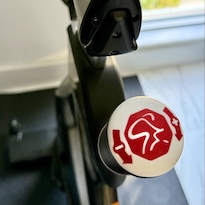How to Coach Resistance in Your Indoor Cycling Class, Part 3: Start Strong—Teaching the First Touch of Resistance
In parts 1 and 2 of this series, I discussed two common but ineffective approaches to cueing resistance. In this third installment, I’ll show you how to teach resistance in a way that sets your riders up for success from the moment they start pedaling.
This part focuses on the warm-up. You’ll learn how to help your riders establish that very first touch of resistance—what I call their baseline—so they’re not spinning with nothing under them and are better prepared for the workout ahead.
Your Starting Resistance Is the Most Important Resistance
Cueing resistance effectively begins with the warm-up. This is when every rider should establish their own baseline—not one based on generic turns of the knob or a resistance scale. The right starting point happens at a comfortable cadence (typically mid-70s to mid-90s rpm).
I like to use music to guide cadence and often choose warm-up songs in the 80s bpm—but I’m flexible here. Each rider warms up best at their own rhythm, as long as it’s not so fast it spikes heart rate too soon, or so slow that they feel the need to add too much resistance to feel anything. I suggest a range of mid-70s to mid-90s for a warm-up cadence.
Note: The terms “baseline” or “base plus” can be confusing if thrown around without explanation. Make sure you’ve read this article to understand how not to use them!
Low Resistance Does Not Mean No Resistance

There is never a valid reason to ride an indoor bike with zero resistance. Outdoors, there’s always resistance: friction in the drivetrain, wind, gravity, the road itself. Even in your easiest gear, you’re still pushing against something.
Riding indoors with no resistance—especially on bikes with heavy flywheels that pull the pedals around—is like riding a bike without a chain. You’d fall over. You wouldn’t go anywhere. That’s how ineffective it is.
Yet it happens in classes all the time: riders spinning at high cadences with no load, thinking they’re working hard just because their heart rate is up. They’re not. There might be some metabolic activity, but it’s not enough to make meaningful progress.
Fortunately, bikes like the Stages SC series and Life Fitness IC7 are designed with a bit of built-in resistance even when the dial is turned all the way down. That helps avoid the zero-resistance trap. But some bikes still don’t have this feature, so you have to teach it.
How to Coach That First Bit of Resistance
Help your riders discover their warm-up baseline from the very beginning. Through your cues, you’ll guide them to add just enough resistance to feel the road beneath them—a flat road, in an easy gear, at a smooth, steady cadence.
Here are some real-time cues you can use during your warm-up—use the cues that feel natural to you:
Next time in part 4, we’re cranking it up. I’ll show you how to help your riders dial in the right resistance for harder efforts—and why matching it to cadence is the secret sauce to making your profiles work.
For your review:
How to Coach Resistance in Your Indoor Cycling Class, Part 1
How to Coach Resistance in Your Indoor Cycling Class, Part 2


I am just getting to read these articles. Great stuff! Any chance you could elaborate on this quoted comment in the article above or direct me to previous postings at ICA that address this phenomenon of high heart rate without doing true work. I am trying to find ways to explain this to my students who still associate high heart rate with work. “The analogy of riding without a chain may serve as a deterrent to some, although the fact that heart rate can still skyrocket even with no resistance may unfortunately make them believe they are doing work. They are not.” Thanks so much!
Thanks for this info! Very helpful! Even though there is similar archived info, I can get quite distracted going back in the archives because there’s so much great content! I have been teaching to RPE for a while but my descriptions have gotten kind of stale. It’s nice to have some new ways to describe the desired effort and I will be trying them tomorrow!
Also, it would be really great if there was a way to “star” or save an article to be able to refer to it again later on!
Thanks
yes, I first wrote a series on this topic in 2011, but I made a lot of changes this time around. I’ve evolved, technology has changed, and I write better now than I did 6 years ago when I first covered this (thanks to my editor)! 😉 You’ll see the most differences in the upcoming part 4.
Thanks for you input. One of my goals is to make it easier to find archived content. We will be better at categorizing and tagging them so you can find what you are looking for more easily.